0.0 Welcome to Introduction to Networks
0.0.1 Message to the Student
0.0.1.1 Welcome
Welcome to the CCNA Introduction to Networks course. The goal of this course is to introduce you to fundamental networking concepts and technologies. These online course materials will assist you in developing the skills necessary to plan and implement small networks across a range of applications. The specific skills covered in each chapter are described at the start of each chapter.
You can use your smart phone, tablet, laptop, or desktop to access your course, participate in discussions with your instructor, view your grades, read or review text, and practice using interactive media. However, some media are complex and must be viewed on a PC, as well as Packet Tracer activities, quizzes, and exams.

0.0.1.2 A Global Community
When you participate in the Networking Academy, you are joining a global community linked by common goals and technologies. Schools, colleges, universities, and other entities in over 160 countries participate in the program. A visualization of the global Networking Academy community is available at http://www.academynetspace.com.
Look for the Cisco Networking Academy official site on Facebook© and LinkedIn©. The Facebook site is where you can meet and engage with other Networking Academy students from around the world. The Cisco Networking Academy LinkedIn site connects you with job postings, and you can see how others are effectively communicating their skills.
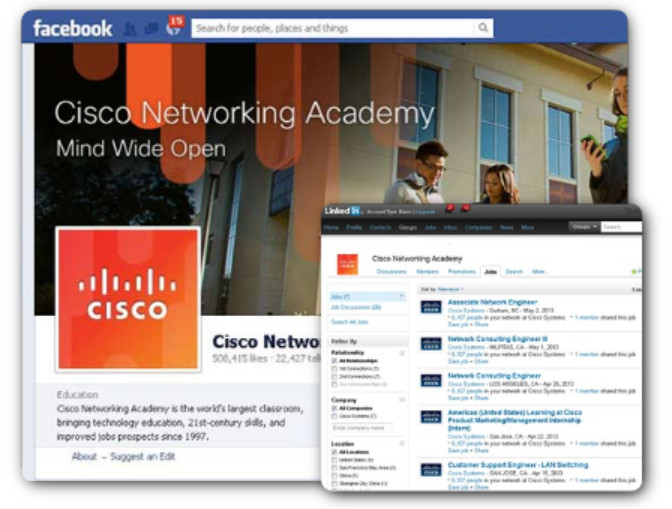
0.0.1.3 More Than Just Information
The NetSpace learning environment is an important part of the overall course experience for students and instructors in the Networking Academy. These online course materials include course text and related interactive media, Packet Tracer simulation activities, real equipment labs, remote access labs, and many different types of quizzes. All of these materials provide important feedback to help you assess your progress throughout the course.
The material in this course encompasses a broad range of technologies that facilitate how people work, live, play, and learn by communicating with voice, video, and other data. Networking and the internet affect people differently in different parts of the world. Although we have worked with instructors from around the world to create these materials, it is important that you work with your instructor and fellow students to make the material in this course applicable to your local situation.

0.0.1.4 How We Teach
E-doing is a design philosophy that applies the principle that people learn best by doing. The curriculum includes embedded, highly interactive e-doing activities to help stimulate learning, increase knowledge retention, and make the whole learning experience much richer – and that makes understanding the content much easier.
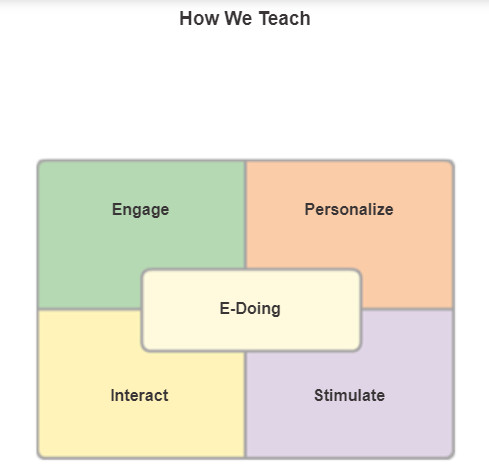 0.0.1.5 Practice Leads to Mastery
0.0.1.5 Practice Leads to Mastery
In a typical lesson, after learning about a topic for the first time, you will check your understanding with some interactive media items. If there are new commands to learn, you will practice them with the Syntax Checker before using the commands to configure or troubleshoot a network in Packet Tracer, the Networking Academy network simulation tool. Next, you will do practice activities on real equipment in your classroom or accessed remotely over the internet.
Packet Tracer can also provide additional practice any time by creating your own activities or you may want to competitively test your skills with classmates in multi-user games. Packet Tracer skills assessments and skills integration labs give you rich feedback on the skills you are able to demonstrate and are great practice for chapter, checkpoint, and final exams.
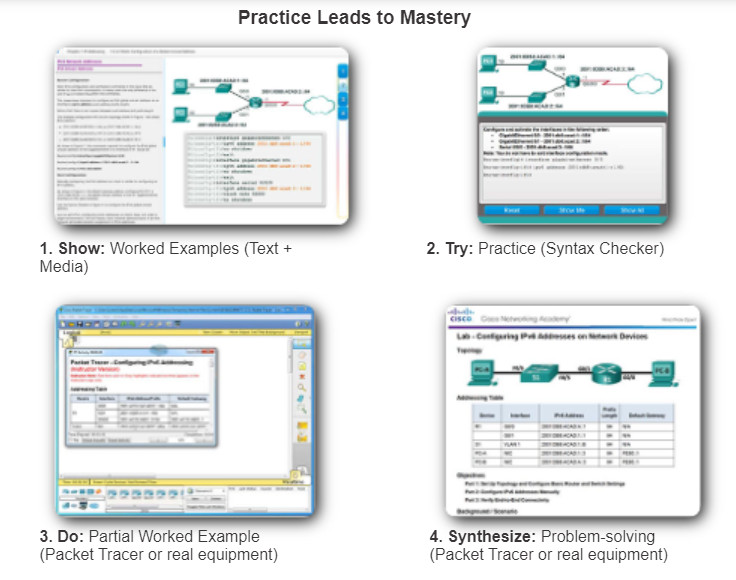
0.0.1.6 Mind Wide Open
An important goal in education is to enrich you, the student, by expanding what you know and can do. It is important to realize, however, that the instructional materials and the instructor can only facilitate the process. You must make the commitment yourself to learn new skills. The following pages share a few suggestions to help you learn and prepare for transitioning your new skills to the workplace.

0.0.1.7 Engineering Journals
Professionals in the networking field often keep Engineering Journals in which they write down the things they observe and learn such as how to use protocols and commands. Keeping an Engineering Journal creates a reference you can use at work in your ICT job. Writing is one way to reinforce your learning – along with Reading, Seeing, and Practicing.
A sample entry for implementing a technology could include the necessary software commands, the purpose of the commands, command variables, and a topology diagram indicating the context for using the commands to configure the technology.

0.0.1.8 Explore the World of Networking
Packet Tracer is a networking learning tool that supports a wide range of physical and logical simulations. It also provides visualization tools to help you understand the internal workings of a network.
The pre-made Packet Tracer activities consist of network simulations, games, activities, and challenges that provide a broad range of learning experiences. These tools will help you develop an understanding of how data flows in a network.
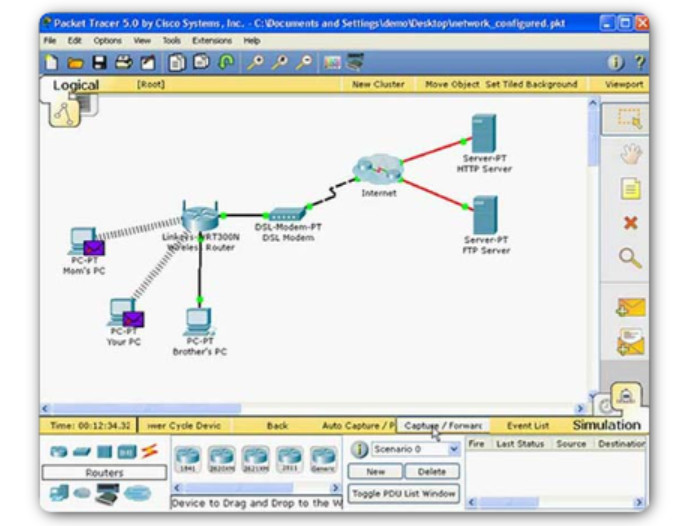
0.0.1.9 Create Your Own Worlds
You can also use Packet Tracer to create your own experiments and networking scenarios. We hope that, over time, you consider using Packet Tracer – not only for experiencing the pre-built activities, but also to become an author, explorer, and experimenter.
The online course materials have embedded Packet Tracer activities that will launch on computers running Windows® operating systems, if Packet Tracer is installed. This integration may also work on other operating systems using Windows emulation.
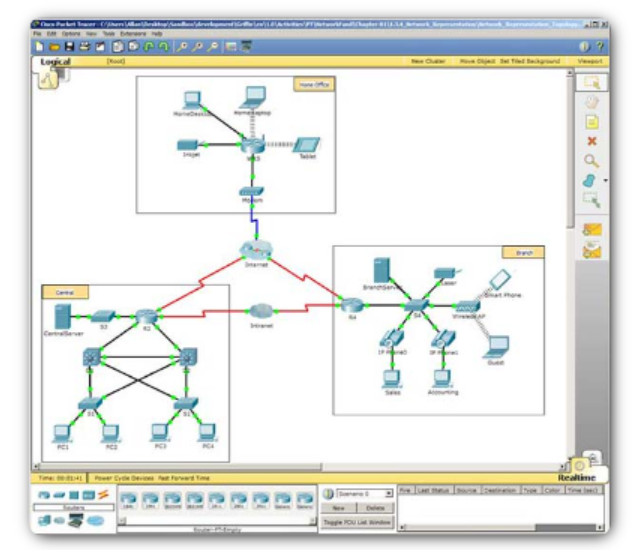 0.0.1.10 How Packet Tracer Helps Master Concepts
0.0.1.10 How Packet Tracer Helps Master Concepts
Educational Games
Packet Tracer Multi-User games enable you or a team to compete with other students to see who can accurately complete a series of networking tasks the fastest. It is an excellent way to practice the skills you are learning in Packet Tracer activities and hands-on labs.
Cisco Aspire is a single-player, standalone strategic simulation game. Players test their networking skills by completing contracts in a virtual city. The Networking Academy Edition is specifically designed to help you prepare for the CCENT certification exam. It also incorporates business and communication skills ICT employers seek in job candidates.
Performance-Based Assessments
The Networking Academy performance-based assessments have you do Packet Tracer activities like you have been doing all along, only now integrated with an online assessment engine that will automatically score your results and provide you with immediate feedback. This feedback helps you to more accurately identify the knowledge and skills you have mastered and where you need more practice. There are also questions on chapter quizzes and exams that use Packet Tracer activities to give you additional feedback on your progress.
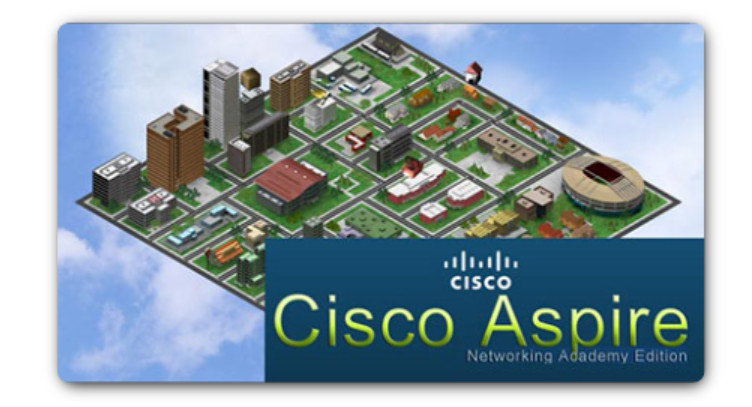
0.0.1.11 Course Overview
As the course title states, the focus of this course is on learning the fundamentals of networking. In this course, you will learn both the practical and conceptual skills that build the foundation for understanding basic networking. You will do the following:
- examine human versus network communication and see the parallels between them
- be introduced to the two major models used to plan and implement networks: OSI and TCP/IP
- gain an understanding of the “layered” approach to networks
- examine the OSI and TCP/IP layers in detail to understand their functions and services
- become familiar with the various network devices and network addressing schemes
- discover the types of media used to carry data across the network
By the end of this course, you will be able to build simple LANs, perform basic configurations for routers and switches, and implement IP addressing schemes.

